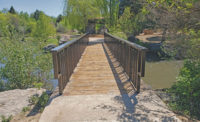City of Tampa, Julian B. Lane Riverfront Park
Tampa
BEST PROJECT
Owner: City of Tampa
Contractor: Skanska USA Building Inc.
Lead Design Firm: Civitas Inc.
Structural Engineer: Robert Silman Associates
MEP Engineer: VoltAir Consulting Engineers Inc.
Despite its close proximity to Tampa’s bustling downtown area, this nearly half-century old park had been virtually abandoned. As part of a $35-million renovation, the project team first had to address many remnants of the park’s past. Built atop a razed former neighborhood, the site was filled with debris and clay that had to be excavated and replaced with clean fill. Poorer-than-expected subsurface conditions required crews to augment the new event center’s spread footings with rock columns. Rectifying unforeseen issues required nearly four months, putting added pressure on an already tight construction schedule.
Underground debris also complicated erection of a new realigned seawall, complicating installation of new precast sheet panels. Contractors removed the panels so that the course could be over-excavated and replaced with new fill. A problem arose in the seawall’s 100-ft-long transition from land into the river. Because the actual river bottom was significantly deeper than indicated by original bathymetric survey data, the already fabricated precast panels were too short. With time of the essence, the project team and owner agreed to switch to more readily available steel sheet piles.
Lean construction practices helped the project team optimize efficiencies during the project’s tight schedule, while cost savings were achieved by refining designs for the park’s furnishings and recreational amenities, as well as for the timber design of the new events center. Opening what had been proprietary lighting fixtures to competition saved the project nearly $1 million. To enhance construction phase safety, new concrete retaining walls adjacent to an existing bridge embankment were relocated and augmented with a unit masonry wall that proved safer and less complex to install.
Some of the original park’s unique elements were incorporated into the new design, and approximately half of the existing trees were saved through pruning and relocation.
Today, the 23-acre park features athletic courts, a synthetic turf field, sheltered play areas and a greenway trail. A new dock is tucked away from the main river to improve access for rowers, kayakers and other users.
Back to "Southeast's Best Projects Shine With Stellar Results"




